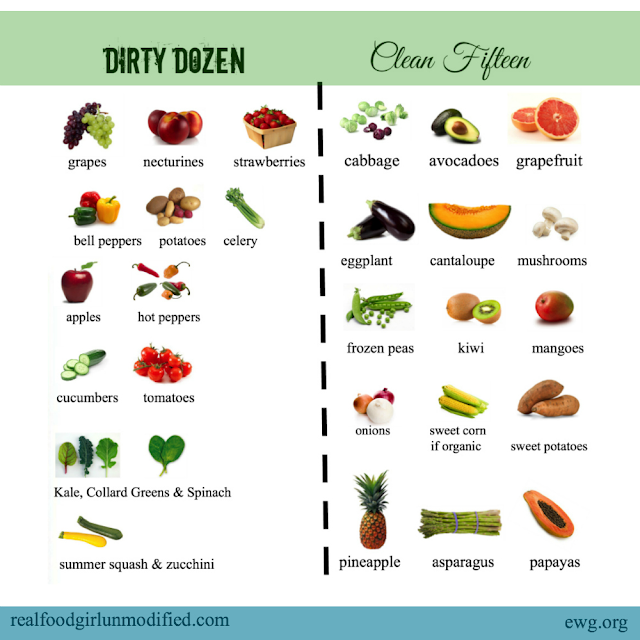Every two years, a watchdog group of Environmentalist, gain the data from the US Department of Agriculture and USDA and publish a list of vegetables and fruits which have high content of pesticides and a list with negligible amounts of pesticides. When they do the testing, the peel the inedible skins and wash those which can be consumed. TIP: Always wash your vegies and fruits.
2022 results: Dirty Dozen
More than 70% of the conventionally grown produce had detectable pesticide residue, the Environmental Working Group found. These fruits and vegetables were found to have the most pesticide residues this year:
- 1. Strawberries
- 2. Spinach
- 3. Kale and collard and mustard greens
- 4. Nectarines
- 5. Apples
- 6. Grapes
- 7. Bell and hot peppers
- 8. Cherries
- 9. Peaches
- 10. Pears
- 11. Celery
- 12. Tomatoes
2022 results: Clean 15
Almost 70% of the Clean Fifteen fruit and vegetable samples had no detectable residues of pesticides, the Environmental Working Group found. Avocados and sweet corn were the cleanest, with less than 2% of samples showing any detectable pesticides.
- 1. Avocados
- 2. Sweet corn
- 3. Pineapple
- 4. Onions
- 5. Papaya
- 6. Sweet peas (frozen)
- 7. Asparagus
- 8. Honeydew melon
- 9. Kiwi
- 10. Cabbage
- 11. Mushrooms
- 12. Cantaloupe
- 13. Mangoes
- 14. Watermelon
- 15. Sweet potatoes
TIP concentrate on the CLEAN DOZEN (or 15)
Of course the Agricultural industry would let you believe that pesticides at these levels are not harmful. But dont tell that to agricultural workers, first described in El Salvador, who suffered Renal failure related to the exposure to the pesticides .
The first reference of this new disease was an epidemiological description in a study published by García-Trabarino et al. after the evidence of a significant upturn of patients with advanced CKD in El Salvador. In this publication, 205 incident dialysis patients were analyzed, observing that at least 67% had no known risk factors for the development of kidney disease, but they did have a high exposure to pesticides and insecticides. Since then, the incidence of CKD of unknown etiology has increased considerably in Central America, but also in other tropical regions of the world, such as Sri Lanka or India, acquiring the broader name of chronic interstitial nephritis of agricultural communities (CINAC).
The rate of Chronic Disease is higher in USA than Europe, once again the usual culprits are blamed: Diabetes and Obesity.
Is there a possibility that Diabetes and Diabetes are due to the chemical onslaught on to the bodies of the Americans? The same reasons were given for the excess deaths in the USA during the Covid 19 pandemic (ongoing).
I am an Endocrinologist with an inherent interest in Human Metabolism and I work with Indigenous peoples: they all laugh in agreement with me when I advise them:
Eat Food .and not Chemicals
The following study has some clue how to clean fruits and veggies
Fruits and vegetables do get washed before they hit the shelves -- for example, with
bleach solutions.
But some researchers have wondered whether that wash was enough.
"We want to see whether or not the factory level (of washing) is already effective" at removing pesticides, said
Lili He, a food scientist at the University of Massachusetts, Amherst. On Wednesday, He published
a study comparing bleach, tap water and baking soda in removing two pesticide residues: phosmet and thiabendazole.
In the new study, baking soda came out on top. The authors say this is because the pesticides degrade faster in baking soda, making them easier to physically remove by washing.
She said this could be accomplished by mixing roughly a teaspoon of baking soda into two cups of water, though the measurement "doesn't have to be that strict."
Bleach, on other hand, is primarily meant to kill bacteria and other germs that might build up, He said.
In He's study, no method was 100% effective in removing pesticides from the apples, which were not taken directly from orchards but rather coated with pesticides in the lab. This is partly because thiabendazole is a "systemic" pesticide, meaning it penetrates below the surface. He's team estimated that 80% of thiabendazole residues were removed by the baking soda solution, versus over 95% of phosmet.
TIP: A bit of Baking soda seems. to help.
EAT FRUIT, THINK OF THE HEALTHY FIFTEEN, WASH THEM WELL, BUY ORGANIC WHEN YOU CAN





